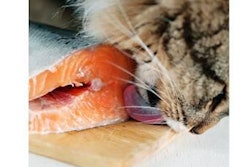Petfood, especially kibbled petfood, is often derisively described as “brown and round.” It comes by this honestly, because most of the ingredients used to make petfood, be it extruded kibbles, canned meats or baked biscuits, are tan to brown. So the resulting foods end up much the same— various shades of brown—that is, unless we add some color. Not that the dogs or cats care; for all intents and purposes they are color-blind. But it is more appealing for the pet owner if the food has some unique color that makes it stand out.
There are numerous “colors” that have been used in petfoods for decades. They tend to be in products merchandised in the grocery category and have utilized artificial dyes like FD&C Red No. 40, Yellow No. 5, Blue No. 2, etc., or modified minerals like titanium dioxide (a whitener) and iron oxide (various shades of red). These have been approved since the advent of the Pure Food and Drug Act of 1906.
In the AAFCO Official Publication (2014) they can be found in Section 87 Special Purpose Products and they defer to the Code of Federal Regulations (CFR); Title 21, Food and Drugs Administration, Department of Health and Human Services; Sub-Chapter A—General; Part 73 – “Color Additives...” In the European Union these coloring agents fall under the rules for E numbers. The synthetics are very potent and inexpensive coloring agents. They are sometimes criticized for their potential to stain if the animal regurgitates on flooring or furniture in the home and they aren’t without some controversy for health matters. Some of the synthetic dyes have been delisted by the FDA over the years for these concerns over health and safety. This has tainted consumer confidence in the entire group of synthetic coloring agents.
For many pet owners, “Natural” is a primary driver for petfood or treat purchase. This extends clear down to the colors. In our own diets we think of natural colors like red from tomatoes, green from spinach or purple from blueberries. The challenge is natural ingredients in their native form often lack the intensity and brilliance when compared to the synthetics. Thus, most of the natural coloring agents are extracts or concentrates from leaves, roots, fruits, spices and even insects. Prospective coloring ingredients that can best fit petfood applications include annatto, tomatoes, paprika, beets, carmine, alfalfa, turmeric and caramel.
In the plant world, carotenoids provide a wide array of natural colors that also have potent antioxidant capabilities. Annatto is a reddish-orange extract from achiote tree seeds’ pericarp or hull. The color is commonly used in deeply red-orange cheeses and fits well with “cheese” imagery pet treats. The color is derived from the carotenoid bixin and saponified to a water soluble norbixin for use in water-based applications.
Tomato extract and concentrate is a red to red-brown viscous oleoresin extract from tomato pulp after juice removal from edible tomatoes. The main coloring agent is the carotenoid lycopene which is a potent antioxidant, as well as adding reddish-brown depth to a kibble.
Paprika and paprika oleoresin come from the dried pod of mild capsicum peppers. While use of peppers is not commonly considered a good choice for petfoods, most paprika these days is sweet, not hot to the taste, and is acceptable in small amounts. The dark red to reddish-yellow color is predominately due to the carotenoid zeaxanthin.
Compounds found in edible beets (dehydrated beets or beet powder) are a dark red. The colors are betalain pigments which include betanin, isobetanin, probetanin and neobetanin. Beet juice also carries with it betaine which can replace some of the choline (a water soluble vitamin) in the animals’ diet.
Carmine is the extract from the scale insect cochineal. It can also be labeled as cochineal extract and provides a dark blood red hue to light-colored foods.
On the green side, chlorophyll either as a plant material or as sodium copper chlorophyllin is a green black powder prepared by chlorophyll saponification and replacement of magnesium by copper to make it more stable. It is extracted from alfalfa using various polar solvents (acetone, ethanol or hexane) and has been used in dental chews and “mint” products.
For the yellows, the ground rhizome of the turmeric plant is extracted to produce an oleoresin. The active ingredient is curcumin and it imparts the distinctive yellow color most often associated with French’s mustard and the flavor associated with curries. Besides its pigmenting properties, it possesses significant health benefits through its antioxidant properties.
Coming full circle back to brown, caramel is the dark brown liquid or solid resulting from heat treatment of food-grade carbohydrates such as dextrose, molasses, sucrose, etc. There are some synthetic forms of this ingredient which have come under scrutiny, but natural caramel colorings are available and are effective for adding a dark rich brown to foods desiring a “roasted beef” appearance.
Effectively adding these ingredients to petfoods is very dependent on the desired result, relative strength of the preparation purchased and the color intensity of the food item be colored. Many are effective at parts per million and are unlikely to exceed 1% of the formula. At this low level they would typically not have a significant impact on flavor, but this should be validated. It must be noted that adding these coloring agents to the food might leave color residue on facilities and processing equipment and may increase cleanup requirements between production runs. Further, since these colors are natural, they may be diminished by thermal processes and light exposure. Thus, care needs to be taken during product development to account for any of these differences relative to the intended outcome.
Effective use of natural colors and pigments takes active experimentation and quality standards to achieve the intended goals. With effort and attention to detail, a meaningful solution to enhance petfood color can be achieved. When done successfully, the resulting product can have greater pet owner appeal and a healthy side-effect for the pet.


















